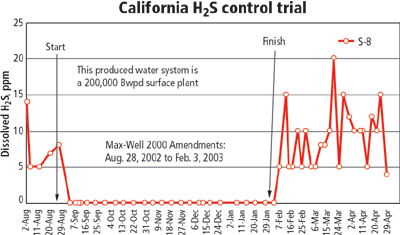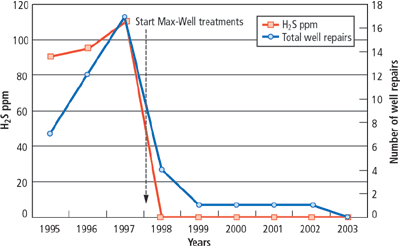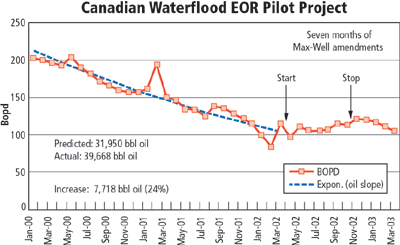Production Treatments
New nitrate-based treatments control hydrogen sulfide in reservoirs
And in most cases, these microbes result in increased oil production.
Donald O. Hitzman, Geo-Microbial Technologies, Inc.; and Mike Dennis, The LATA Group, Inc., Ochelata, Oklahoma
Biogenic formation of hydrogen sulfide has, and will, occur in most oil and gas reservoirs – particularly those flooded with sea water. Hydrogen sulfide causes high costs and serious operational problems, including reservoir souring, sulfide corrosion, iron sulfide plugging, reduced product value, and health and environmental hazards. Historically, the sulfide problem has been treated with toxic biocides, which have proven to be costly and mostly ineffective.
The petroleum industry is now implementing a nitrate-based microbial treatment technology for both the prevention and removal of sulfide from reservoirs, produced water, surface facilities, pipelines and gas storage reservoirs, as well as increasing oil recovery.
This innovative reservoir treatment technology recognizes that detrimental sulfate-reducing bacteria (SRB), which produce sulfide, can be replaced by a naturally occurring suite of beneficial microorganisms enhanced by the introduction of an inorganic nitrate-based formulation.1 This designed manipulation of the reservoir ecology has been termed Biocompetitive Exclusion (BCX) technology – simply put, the “good bugs” outcompete the “bad bugs.” Application results have been recently presented at the NACE Corrosion conference as well as at several SPE conferences and workshops.2–5
NITRATE/NITRITE COMBINATION
Key to this development is the discovery that the SRB, while reducing sulfate to sulfide, utilize naturally occurring Volatile Fatty Acids (VFA) in the reservoir waters as their carbon source. With a BCX treatment, the introduction of low concentrations of a nitrate/ nitrite formulation will more readily and energetically replace the sulfate as an electron acceptor, which encourages the already present, natural Nitrate-Reducing Bacteria (NRB) population to proliferate and use the VFA preferentially, thereby denying the SRB this required nutrient. Since the alternate NRB populations are already present, the technology does not require the addition of organisms and would operate in all reservoirs that contain microbial populations.
The BCX formulation is composed of a mixture of nitrate/ nitrite salts that can be adjusted and altered to conform to different reservoir characteristics, water compositions and sulfide concentrations. This ability to tailor the BCX formulations to match the field situation has proven more versatile to treatments in which only the nitrate concentration can be changed. The BCX system functions in-situ, perpetually stimulating targeted indigenous de-nitrifying microorganisms to produce chemical and physical oil-releasing agents. It is literally a gas and chemical “factory” that is situated within the reservoir, where its effectiveness is optimized.
The BCX technology clearly indicates its novel action and advantages for effective sulfide suppression when compared to previous biocide treatments, Table 1.
| |
Table 1. Comparison of BCX technology to biocide treatments for sulfide control. |
|
| |
BCX technology |
Biocide treatment |
|
| |
|
|
| |
Non hazardous inorganic salts |
Toxic and hazardous chemicals |
|
| |
Grows selectively beneficial populations |
Tries for complete kill |
|
| |
Lower cost |
Relatively expensive |
|
| |
Continuous in-situ cell production |
Biocidal action reduced by dilution |
|
| |
Microbial actions within pore matrix |
Biocide resistance develops |
|
| |
Penetrates throughout reservoir |
Depleted action by absorption |
|
| |
Sulfide prevention |
Partially successful sulfide control |
|
| |
Sulfide removal |
No sulfide removal |
|
| |
Environmentally safe |
Environmentally hazardous |
|
|
In addition, the use of the versatile BCX system has other benefits that increase its economic value, including decreased capital, operating and maintenance costs; reduced corrosion expense, tertiary tax credits and its success in increased EOR.
PROACTIVE AND REACTIVE
There are two major approaches to solving the sulfide problem: proactive and reactive. In the reactive program, the BCX treatment is added to an already contaminated and sulfide-generating system, to decrease and remove the already existing SRB populations and sulfide concentrations. Such systems are usually treated on the injection side to establish the beneficial population throughout the reservoir or system.
In the proactive methodology, the treatment is initiated prior to contamination of the reservoir, so that the SRB populations never become dominant and the sulfide problem is prevented. Obviously, the proactive treatment is preferred, but, unfortunately, many major reservoirs throughout the world have already turned sour, so emphasis has been on remedial reactive treatments. Several examples of the BCX technology to treat sulfide problems are illustrated in Figs. 1 and 2. BCX formulae are referred to as LATA Group's proprietary and patented Max-Well 2000 treatments.
 |
Fig. 1. Produced water surface facility 200,000 Bwpd.
|
|
 |
Fig. 2. Stripper gas well, 100 Mcfd, sulfide control treatments: 6 years.
|
|
These results are reinforced by reports that both proactive and reactive nitrate treatment projects are now operational at several North Sea platforms, Table 2.2–4 Such reported successes have resulted in the nitrate technology being applied to other North Sea fields including Norne, Statfjord and Valhall.
| |
Table 2. Reported North Sea nitrate treatments. |
|
| |
• |
Maersk: |
|
| |
|
– |
Skjold field – reduction of sulfide production of 100 kg/day as monitored from one producer. Overall field treatment clearly arrested expected sulfide production |
|
| |
|
– |
Halfdan field – productive treatment inferred nitrate treated successfully prevented reservoir souring. |
|
| |
• |
Statoil: |
|
| |
|
– |
Gullfaks field: nitrate replacement for biocide decreases SRB and increased NRB, reduced sulfide concentration at water breakthrough by 50%, and reduced corrosion rate. |
|
| |
|
– |
Veslefrikk field: corrosion rate in water injection pipeline reduced to 0.2 from 0.7 mm/yr. |
|
| |
• |
BP: |
|
| |
|
– |
Foinaven field: after 1 year, when breakthrough of nitrate, exposed sea water was expected, the sulfide production dropped 90%. |
|
|
INCREASED OIL RECOVERY
The old axiom that microorganisms cannot significantly influence reservoirs has been disproved by the progressive biogenic sulfide contamination of massive reservoir and production facilities. Prolific SRB growth and activity best illustrates the potential for microorganisms to quickly affect entire systems – no matter the size – and validates the potential for an alternative beneficial replacement microbial community to exert a very large positive effect within an observable and acceptable timeframe. Thus, while the immediate success of the established BCX technology for sulfide control can be easily demonstrated, measured and documented, the full impact of this technology includes the equally important results that show the technology has the potential to significantly and simultaneously increase oil recovery.
The observed and reported 20% oil increase results from the growth of the indigenous NRB microflora, which uses the nitrate/ nitrite to simultaneously produce products such as gases (CH4, CO2, N2) surfactants, solvents and organic acids – all known oil recovery properties. 5 It must be emphasized that growth of the oil-releasing organisms, and all reactions and product formation, occurs throughout the reservoir, resulting in the synergistic action of such multiple oil-releasing mechanisms and agents. These multiple effects on oil release and mobilization, within the microscopic pore matrix, are not usually encountered or considered. They are summarized in Table 3 for comparison of BCX treatments to conventional CO2, polymer, etc. An example of increased oil recovery by BCX treatments is illustrated in Fig. 3.
| |
Table 3. Enhanced oil recovery (EOR) systems: BCX technology vs. conventional EOR. |
|
| |
BCX Oil Recovery System |
|
Non-Biological EOR Systems |
|
| |
|
|
| |
Self-reproducing units: exponential increase in numbers |
|
Continual dilution and depletion of EOR agent |
|
| |
Multiple oil mobilizing agents are produced simultaneously: solvents, organic acids, gases and surfactants |
|
Usually only a single effect is targeted |
|
| |
Mobility: cells move by their own actions to the trapped oil |
|
Transport is restricted to injection flow patterns |
|
| |
Multiple effects are at pore level and the pore matrix |
|
Action is mainly at the leading edge of chemical injection |
|
| |
Continual in-situ production of oil-releasing agents in all directions from each cell |
|
No in-situ production of agents |
|
| |
In-situ utilization of native reservoir constituents |
|
Less favorable interaction with reservoir constituents |
|
| |
Superior economics achieved by the addition of low-cost amendments |
|
Threshold and continuing project costs are often prohibitive |
|
|
 |
Fig. 3. Weyburn field MEOR pilot: 5 injectors, 11 producers. Project term: 7 months.
|
|
SUMMARY
The destructive and costly effects of sulfide contamination in oil and gas reservoirs and producing systems are well documented throughout the global industry. Directed manipulation and exploitation of naturally-occurring in-situ microorganisms to eliminate and control biogenic sulfide represents fresh, powerful and economic solutions to major problems within the oil and gas industry. Discovery and recognition of the effect of synergistic nitrate-based formulae components, added to anaerobic oil and gas production systems such as reservoirs, wells, pipelines, gas storage reservoirs and produced water facilities, has resulted in a re-examination of the concepts, processes and technical efficiency of biosystem treatments. The long-sought goal of sulfide suppression and elimination in these systems is now a reality.
The results of the sulfide-control technology in surface systems are quickly achieved and easily measured. They provide a model system for examining and evaluating the potential for preferred microbial growth and activities for the purpose of sulfide control and increased oil recovery in reservoirs. The linked, synergistic action of versatile nitrate-based components result in a dual, positive action in-situ that destroys H2S and inhibits continuing sulfide production by SRB, as well as providing a continuous supply of oil-releasing chemicals and gases within the pore spaces where oil is trapped. An increasing wealth of field project evidence validates this new technology. 
LITERATURE CITED
1 Hitzman, D. O., “Method for reducing the amount of and preventing the formation of hydrogen sulfide in an aqueous system,” 1995 US Patent 5,405,531.
2 Haegh, T. “Field experience of using nitrate injection to control sulphide (H 2 S) production in oil field water systems,” 2nd Produced Water Workshop, Houston, Texas, April 21 – 22, 2004.
3 Sunda. C., “H2S inhibition by nitrate injection on the Gullfaks field,” NACE Corrosion conference, New Orleans, 2004.
4 Larsen, J. “Prevention of reservoir souring in the Halfdan field by nitrate injection,” NACE Corrosion conference, New Orleans, 2004.
5 Hitzman, D. O., “Recent success – MEOR using synergistic H 2 S prevention and increased oil recovery systems,” SPE paper 89453, Tulsa, Oklahoma, April 21, 2004.
THE AUTHORS
|
 |
Donald Hitzman is research director for Geo-Microbial Technologies, Inc., since 1985. He is also VP of research for the LATA Group. Dr. Hitzman headed microbiological research at Phillips Petroleum between 1956 and 1985 following PhD research at the University of Illinois and a Fulbright scholarship in Australia. His pioneering geomicrobiological research investigations, reported in numerous publications and over 65 US patents, cover microbiological and geochemical exploration surveys, and his experience in oil production operations have earned him world wide recognition in all phases of petroleum microbiology. He can be contacted at: don@gmtgeochem.com.
|
 |
Michael Dennis is director of field operations for the LATA Group, and joined Geo-Microbial Technologies, Inc. in 1995 after completing research for the National Institute for Petroleum and Energy Research. He owned and operated Microbial Systems Corp. from 1983-1994 for commercialization of microbial enhanced oil recovery technologies, which provided extensive experience for planning and conducting numerous microbial projects for increasing oil recovery. He invites your comments at: mike@latagroup.com.
|
| |
|
|







